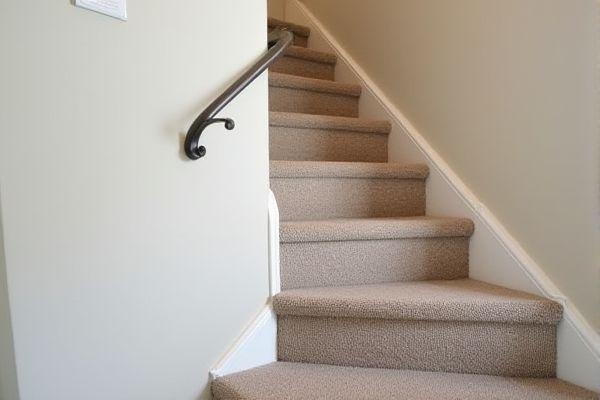
Stair caps provide a sleek, protective edge for stairs, enhancing durability without altering the original tread design, while bullnose offers a rounded, decorative finish that adds safety and style to stair edges. Explore the article to discover which option best suits your staircase needs and aesthetic preferences.
Table of Comparison
| Feature | Stair Cap | Bullnose |
|---|---|---|
| Definition | A protective trim installed over stair edges for durability. | Rounded edge finish on stair treads for safety and aesthetics. |
| Material | Metal, PVC, wood, or composite materials. | Wood, concrete, stone, or tile. |
| Purpose | Protects stair edges from damage and wear. | Creates a smooth, curved edge on stairs enhancing safety. |
| Installation | Fitted over existing stair edges; often surface-mounted. | Built into the stair tread during finishing or remodeling. |
| Durability | High; resists impacts and abrasion. | Moderate; depends on base material strength. |
| Visual Style | Can be visible trim; varies by material and finish. | Seamless rounded edge; cleaner, integrated look. |
| Cost | Typically lower; easy retrofit option. | Higher; requires carpentry or finish work. |
Introduction to Stair Cap vs Bullnose
Stair caps and bullnose are popular finishing options for stairs, each offering unique design and safety benefits. Stair caps provide a sleek, protective overlay that covers the stair tread edges, enhancing durability while preventing wear. Bullnose features a rounded edge that softens the stair profile, improving safety by reducing sharp corners and adding a classic aesthetic to your staircase.
What is a Stair Cap?
A stair cap is a protective covering installed on the edge of a stair tread to enhance durability and safety by preventing wear and reducing slip hazards. Typically made from materials like wood, metal, or PVC, stair caps also provide a finished look while protecting against chipping and damage. Unlike bullnose edges, stair caps are separate pieces that are applied over the existing tread edge for added reinforcement.
What is a Bullnose?
A bullnose is a rounded edge design commonly used on stair treads to provide a smooth, curved finish that enhances safety and aesthetic appeal. Unlike stair caps, which are typically flat overlays designed to cover and protect existing stairs, bullnose edges extend beyond the riser, creating a visually pleasing contour that reduces trip hazards. Bullnose stair designs are popular in both residential and commercial settings for their durability and modern look.
Key Differences Between Stair Cap and Bullnose
Stair caps and bullnose are both stair finishing elements designed to improve safety and aesthetics, but they differ in design and application. Stair caps typically cover the entire tread and riser junction, providing a smooth, rounded edge that enhances slip resistance and protects the stairs from wear. Bullnose refers to a rounded edge profile usually applied only to the stair tread front, emphasizing a softer contour without full tread coverage, ideal for staircases needing a decorative touch.
Pros of Using Stair Cap
Stair caps provide enhanced durability by protecting stair edges from wear and tear, extending the life of the stairs. They offer a sleek, uniform appearance that hides imperfections and creates a polished look. Installation of stair caps is cost-effective and simple, making them a practical choice for both aesthetic and functional improvements.
Pros of Using Bullnose
Bullnose stair treads offer enhanced safety by featuring rounded edges that reduce the risk of injury from sharp corners. The smooth, curved design improves durability by minimizing edge wear and chipping compared to traditional stair caps. Aesthetic appeal is elevated as bullnose provides a seamless, elegant finish that complements various interior design styles.
Stair Cap vs Bullnose: Aesthetic Comparison
Stair caps provide a streamlined, modern look with clean, straight edges that enhance contemporary design aesthetics. Bullnose edges feature a rounded, soft curve offering a classic and traditional appearance that complements vintage or rustic staircases. Choosing between stair cap and bullnose depends largely on the desired visual impact and architectural style of the space.
Installation Process Comparison
Stair cap installation involves precisely measuring and cutting the cap to fit over the stair nosing, followed by securing it with adhesive or nails, ensuring a seamless and durable finish. Bullnose installation requires rounding and smoothing the edge of the stair tread, often using a router or specialized molding, then attaching the bullnose piece to create a rounded edge that enhances safety and aesthetics. Both processes demand careful alignment and finishing touches, but stair caps generally offer quicker installation as they are prefabricated and simply applied, while bullnose steps require more detailed carpentry skills and customization.
Cost Comparison: Stair Cap vs Bullnose
Stair caps generally offer a more budget-friendly option compared to bullnose due to their simpler manufacturing process and easier installation, which lowers labor costs. Bullnose stairs, featuring rounded and smooth edges, tend to be pricier because of the additional craftsmanship required and the higher material usage. Your choice between stair cap and bullnose should consider these cost differences alongside the aesthetic and safety benefits each provides.
Which Option is Best for Your Stairs?
Choosing between stair caps and bullnose depends on durability, aesthetic appeal, and safety requirements. Stair caps offer a protective overlay that enhances longevity and is ideal for high-traffic areas, while bullnose provides a smooth, rounded edge that prevents sharp corners and adds a classic finish. For optimal stair safety and style, consider stair caps for heavy use and bullnose for a traditional, elegant look.
 homyna.com
homyna.com